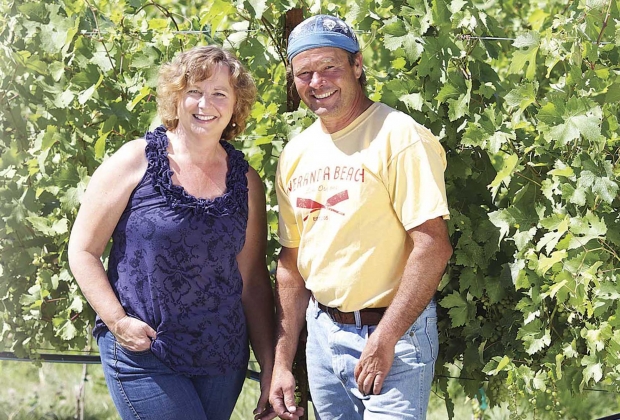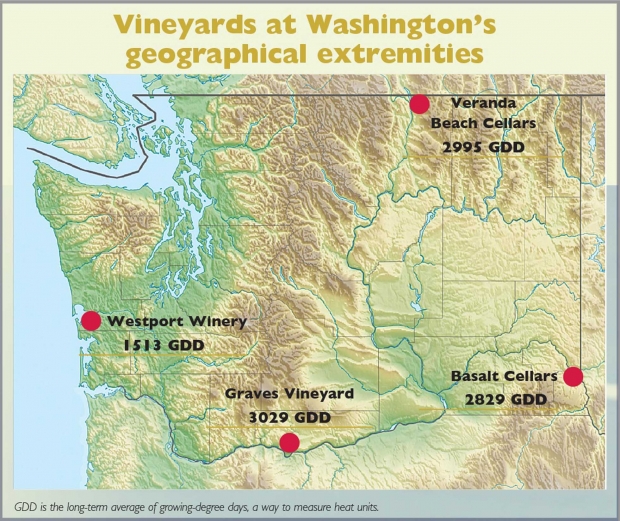
Veranda Cellars winemaker Katy Perry and Finis Hale, vineyard manager. (Courtesy Veranda Beach Cellars)
Four wine grape vineyards in Washington State hold the distinction of being the most northerly, easterly, southerly, and westerly.
The vineyards, though hundreds of miles apart and with diverse soils and climate, are more alike than different.
Good Fruit Grower went on a quest last fall to locate vineyards representing the four compass points. The journey showed the diversity of wine grape varieties and growing conditions of the state’s wine industry, including varied backgrounds of the vineyard and winery owners.
But the biggest discovery was the shared goals of the vineyardists—a sincere desire to bring the best out of their grapes and wine.
Note:This issue highlights the most northern and southern vineyards in Washington State. |
The Oroville area, abutting the Canadian border, was once known as tree fruit country. But in recent years, a viable wine industry has sprung up in British Columbia on the Canadian side of the border. More than 120 wineries are now in Canada’s Okanagan-Penticton region.
Veranda Beach Cellars, one of Washington’s northernmost vineyards, is located less than a mile south of the border. It’s a relative newcomer to the Washington wine industry—initial vineyard blocks were planted in 2006. To date, 12 acres have been planted. Long-range plans are to have 50 acres of wine grapes planted.
Veranda Beach Cellars joins several already established vineyards and wineries in Oroville, including Copper Mountain Vineyards, planted in Oroville in 1996 and located five miles south of the border, Okanogan Estate and Vineyards (formerly called Gold Digger Cellars and still part of the Gold Digger Apples, Inc., cooperative), planted in 1999, and Ester Bricques Vineyard and Winery, located eight miles south of Oroville.
Veranda Beach Cellars is not your typical vineyard and winery setup.
The vineyard is part of Jim Hammond’s vision for an 860-acre parcel of land that runs from the shores of Lake Osoyoos to the top of Cactus Mountain.
Hammond, managing partner in Veranda Beach Resort, says that the vineyard is a cornerstone of the resort, which includes 1950s-themed beach cottages and vineyard cottages built around the vineyard. An on-site winery, vineyard pavilion, golf course, and amphitheater are planned.
Warm microclimate
Lake Osoyoos is an international lake sharing the boundaries of both Washington and British Columbia.
Osoyoos means “narrowing of the waters” in native Okanagan language. The narrow lake is about ten miles long and is surrounded by steep mountains. The large body of water provides a unique microclimate of hot days, cool nights, and a moderating lake effect on extreme temperatures.
“We have no frost issues with the grapes,” said Finis Hale, vineyard manager, adding there was minimal vine damage after the Thanksgiving freeze of 2010.
The total growing degree-days (a way to measure heat units) in Oroville for 2013 was 3,233, according to an east Oroville weather station connected to Washington State University’s Ag Weather Net. The GDD average is 2,995.
Lake Osoyoos is at the northern tip of the Sonora Desert that runs from Canada to Mexico. Average annual rainfall for the area is less than ten inches. The glacial soils are sandy.
“We’re in the banana belt of north central Washington,” Hammond said during an interview with Good Fruit Grower.
“Lake Osoyoos is a very warm lake, much warmer than Lake Chelan. We’re about two weeks earlier than British Columbia’s Okanagan wine district, which is only 30 miles north. Lake Osoyoos is said to be the warmest lake in the Pacific Northwest.”
The elevation difference between the bottom of the site at lakeshore to the top of the parcel on Cactus Mountain is about 450 feet. The southwest slope, where the vineyard is planted, has good sun exposure and air drainage.
Vineyard manager Hale said the vines are trained to the vertical shoot position trellis system and microsprinklers are used under the vine for irrigation.
Award-winning wines
Three red wine grape varieties (Sangiovese, Barbera, and Cabernet Franc) and one white (Riesling) are planted in the Veranda Beach Estate vineyard.
Hammond is serious about growing high-quality grapes that will produce premium, estate wines and has hired a consultant with experience establishing vineyards in the region and a very qualified and capable winemaker.
Katy Perry, winemaker and co-owner of Tildio Winery at Manson, near Chelan, also serves as winemaker for Veranda Beach Cellars. She produced 250 cases of wine from the first vintage in 2010, and has already doubled that volume. Veranda Beach wines are made at Tildio Winery.
Thus far, three wines have been made: Regatta Rosé, a blend of estate Barbera and Sangiovese; Collage, a blend of Barbera, Sangiovese, and Cabernet Franc; and Lakehouse, made of estate Riesling grapes.
Last May, the winery entered its first wine competition, the Seattle Wine Awards, the largest and most comprehensive independent Washington wine recognition program. The Lakehouse and Regatta Rosé both won double gold medals, and the red blend Collage won silver.
Resort and vines
Hammond, with a history of resort development in British Columbia, said he saw potential for a great vineyard location when he got involved with the Veranda Beach project.
“I was looking for something to build my vision of family-oriented cottages,” he said. “When I saw the southwest exposure and sloping land for drainage that comprised the upper part of the parcel, I saw vineyard potential and the opportunity to build my dream.
Establishing a high-quality vineyard has always been one of the foundation pillars for the Veranda Beach development plan.”
Zoning laws in British Columbia prohibit development of existing agricultural land, he said, but not so in Washington State. The resort has become a popular vacation designation for Canadians as well as Americans.
Veranda Beach Resort has about 140 lakeside, vineyard, and beach cottages, a general store, diner, marina, and village center. Of late, the development is building clusters of homes set within the vineyard. “The haciendas are for those who love watching grapes grow but don’t want the responsibility of owning them,” said Hammond.
“They’re designed for zoomers, who are baby boomers that still have a zest for living.” •

(The February 1, 2014 story incorrectly stated Veranda Beach Cellars is Washington’s northernmost vineyard. This story has been corrected reflecting that Veranda Beach Cellars is one of Washington’s northernmost vineyards.)

Leave A Comment